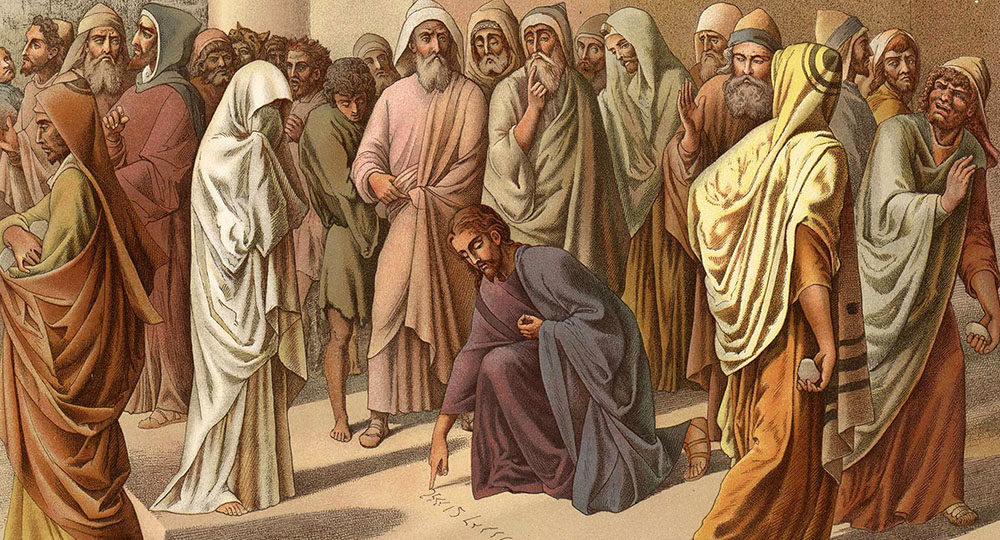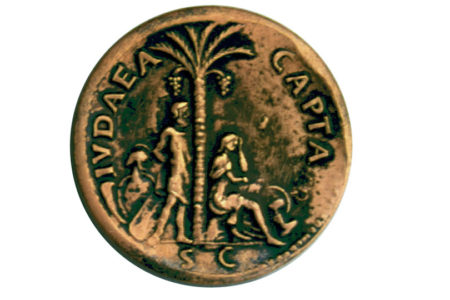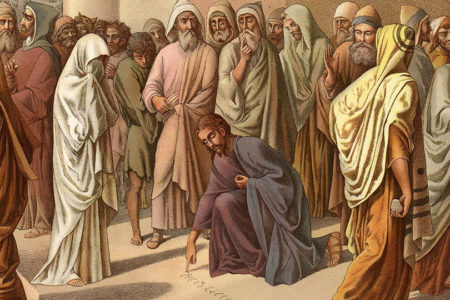The Pharisees: “They Weren’t All That Bad!”
Intense is the only way to describe an informal discussion that took place among several young students of the Bible. The topic being discussed? The Pharisees during the time of Jesus, or, more specifically, the pretentiousness of this group, whom Jesus called white-washed sepulchers (see Mt. 23:27). All but one person argued from the position of Matthew 23, which records the more than stinging indictment of judgment Jesus pronounced upon the Pharisees. The counter argument was given by one student who, while having a background in Judaism, did not possess the years of study in the New Testament that the others had. He acknowledged that the Pharisees addressed in Matthew 23 were indeed hypocrites. But, using the full extent of his powerful voice, he shouted, “In my heart I know they weren’t all that bad!” It came as no surprise to him that he had not convinced even one of the other students of his view.
I was that lone voice nearly 20 years ago, when I was a participant in The Friends of Israel’s summer program. I believed I was correct then, but I had little to offer as evidence. Today, almost 20 years later, I can now explain what I needed then to back up my claim.
The term Pharisee was not self-styled and was actually accusatory. It is believed to have emerged during the time of John Hyrcanus, the great-grandson of Mattathias the Maccabee. John was known by many as “John the Priest” because of his priestly genealogy. He briefly identified himself with a few members of the Jewish council known as the Sanhedrin. This small group of men was passionate for holy living. They were so passionate, in fact, that they would not associate with anyone or anything that might compromise the piety required in the Torah and the oral law. Thus, they were called Perushim or separated ones. The following definition for Perushim comes from Rabbi Nathan Ben Yehiel of Rome: “Perush is one who separates himself from all uncleanness and from eating anything unclean.” Eventually this word involved into what we know today as Pharisee.
It should not be surprising that such a group existed. Ezra, the Old Testament priest, explained to his readers that he “prepared his heart to seek the law of the Lord, and to do it” (Ezra 7:10). Ezra’s strong commitment to a godly life earned him the title Sopher, which means scribe or writer. Jewish history records the existence of many sopherim (plural) who soon were given the designation men of the book. These sopherim devoted themselves to reading, interpreting, and teaching the Torah. They thrived during the period of the Persians.
Later, when the changing political climate brought the Greeks and their culture into dominance, another group called Hassidim, or pious ones, arose. A minority of Hassidim sat in the Sanhedrin. These pious ones were considered extreme because, unlike others in the council, politics meant little to them. Their singular important focus was loyalty to the covenant promises that God had given. They wanted to uncompromisingly promote and uplift the Torah. The Pharisees could truly trace their existence to these committed groups.
By the time of the Second Temple, Pharisaism was an entrenched sect. Although small in number (Josephus states that there were just six thousand), they cleaved to the pursuit of piety. They taught that the path to righteousness could be achieved only through the study of “Torah, which would lead to carefulness, carefulness would lead to alacrity, alacrity to cleanliness, cleanliness to humility, humility to the fear of sin, the fear of sin to the Holy Spirit, the Holy Spirit to the Resurrection of the Dead.”
The Pharisees enlarged upon the Sopherim system of Torah interpretation by developing an incredibly complicated system of exegesis. They believed that God gave this secretive system directly to Moses on Mount Sinai. They felt that this system gave them the edge on the path to righteousness—a path they hoped would lead to worthiness. Once worthy, they believed they would be given divine help by the Ruah Hakodesh (Holy Spirit).
To be found worthy, then, required discipline and knowledge. With undaunted passion, the Pharisees established schools in all the villages of Israel. Instruction included lessons in both the oral and written law, religious and ethical precepts, and detailed “maps of observation” for the Jewish feasts and Sabbath. From this system of schools came the two most famous schools—those of Shammai and Hillel.
Pharisees were nonexclusive in that they came from the ordinary people or lay people, rather than from the exclusive priesthood. Their zeal, need, and belief in sanctification led them to organize into special groups called havuroth, which they believed would remove them beyond the people of the land (am-ha-aretz). These people of the land, the Pharisees felt, did not know and, in some cases, did not want to know the traditions (oral law) of the ancient sages.
Interestingly, there were different types of Pharisees. In their own writings they describe themselves in seven distinct ways. Of these seven ways, only one was considered good. This clearly demonstrates that the Pharisees saw potential problems within their own ranks. These difficulties included ostentatious public displays of good deeds, false humility, and hypocrisy. The seventh type of Pharisee was the one to which they aspired. This type of Pharisee sought to emulate the Patriarch Abraham, a man of faith and charity. According to Philip Birnbaum, author of Jewish Concepts, the Pharisees “insisted on inwardness and sincere intent and despised all hypocrites and charlatans.” He concludes, “Of all the strange ironies of history, perhaps the strangest is that the word Pharisee is current as a word of reproach.”
In addition to a strong commitment to the holiness and piety that clearly was held by other Jewish groups, the Pharisees distinguished themselves with their unique teachings. They held to an inerrant view of the oral law, the existence of angels, an ultimate day of judgment, and belief in a resurrection of the dead. They also held to an uncompromised view of the Messiah. This Son of David, endowed by God with great power, would liberate His people from oppression and usher in the “end days with the ultimate victory for God’s chosen.”
The New Testament verifies many of these conclusions. Luke 13:31 says, “The same day there came certain of the Pharisees, saying unto him [Jesus], Get thee out, and depart from here; for Herod will kill thee.” Clearly these particular Pharisees were concerned for Jesus’ welfare and obviously held Him in esteem. Acts 5:34 reveals that Gamaliel—the renowned sage of Judaism, director of many Jewish schools, and possibly the grandson of the famous Hillel—“stood…up in the council…and commanded to put the apostles forth a little space.” He was encouraging his peers to hear out the apostles—a fine example of what sincere Pharisees aspired to be.
One of the best examples of what Pharisees stood for is pictured in the well-known meeting between Nicodemus and Jesus recorded in John 3. Nicodemus was a Pharisee, a scholar, and a member of the Sanhedrin. We are told that he came to Jesus at night. Many commentators are quick to theorize that embarrassment or cowardice was behind his evening arrival. It seems clear that the time of day is not critical but, rather, the fact that he came. He came to Jesus. He did not come as an official representative of the Pharisees but as a man shaped by Pharisaic teaching who desired truth and a better walk with the God he loved. That he came by night may be merely an indication of the sincerity of his quest. He arrived at a time when the two teachers would not be distracted or interrupted by others.
Nicodemus addressed Jesus as “Rabbi,” acknowledged Him as a messenger from God, and recognized Him to be, like himself, a teacher. Obviously Nicodemus had paid attention to the teachings of the Galilean. He was befuddled by the concept of being born again, although he should have understood it. Being born from above is no more abstract than the Old Testament doctrine of a circumcised heart taught by the Prophets Moses (Dt. 30:6) and Jeremiah (Jer. 4:4). But the scholar, Nicodemus, just did not get it—not yet.
John mentions Nicodemus again in chapter 7. There Nicodemus chided his fellow religionists with a challenge to investigate the words and works of Jesus. Like any good Pharisee, Nicodemus was willing to speak out for the truth, even though he might be perceived as aligned with the Galilean. Nicodemus was closer to the truth than the other Pharisees.
John provides his third and final view of Nicodemus in John 19:39–40. By this time he was a different man spiritually than he was in chapter 3. Perhaps he recognized a brotherhood of the true faith of their forefather Abraham when he partnered with another Pharisee, Joseph of Arimathæa, to gently remove the body of their Savior and Messiah from the place of crucifixion, carry Him to a never-used tomb, and wrap Him with spices and strips of linen.
As we think of the sovereignty and providence of God, it is interesting that it was not the Judaism of the Sadducees that survived the destruction of the Temple. Nor did the practices of the Essenes or Zealots survive—or those of any other sect, for that matter. Today, modern Judaism can trace its core beliefs to the Pharisees.
Why, then, did Jesus deliver such a stinging judgment upon the Pharisees? Probably because these men—the very ones who prided themselves on a thorough examination of divine truth—tragically failed to recognize the Truth when He became flesh. These men—who worked so diligently to be true to the word, to follow it to the letter, who understood the importance of the Messiah and looked for His coming—missed Him.
The Pharisees were not much different from the people you meet today. Look around you. That dedicated, religious, yet spiritually blind person you know could be a Nicodemus—a prime candidate to receive a circumcised heart. Don’t let his or her religiosity keep you from presenting Christ.
Hopefully, some of the facts presented here will complement the passionate heart with which I spoke nearly 20 years ago. Indeed, time has not altered my conviction. They weren’t all bad—many did recognize the Truth when they saw Him.








I was thinking today about St Clement’s words, ‘Fasting is better than prayer’ along with Jesus’ conversations with the Pharisees about fasting. I searched ‘were the Pharisees all bad?’ and up came your wonderful article. Thank you for your illuminating explanation and careful research put in words I can understand, with no theological background. I will be more aware of the Nicodemus when I meet him or her. Thank you, and God bless you.
Geraldine (Marlow, England)
Glad to read this. A couple of times recently in a study group I have been sounded by people telling me that the ‘Pharisees were evil’. Like you I felt like a lone voice, yet something in my couldn’t see this as the whole story. Your article is very helpful – thanks